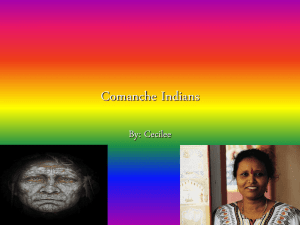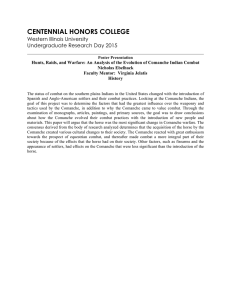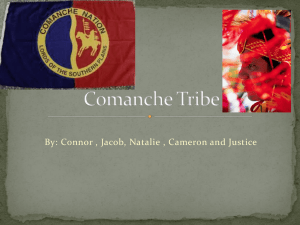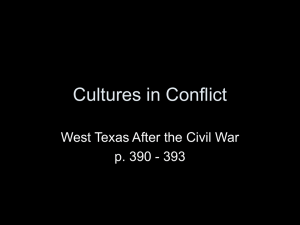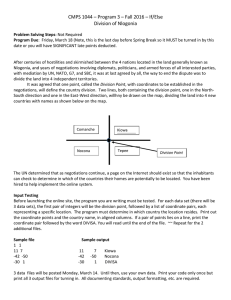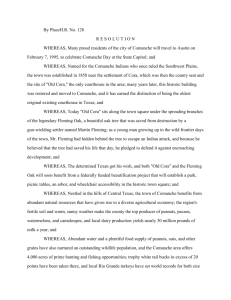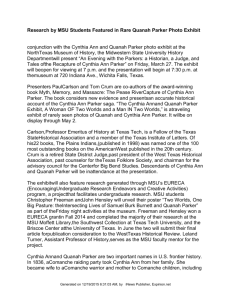Quanah Parker: Comanche Chief Lesson Plan & Activities
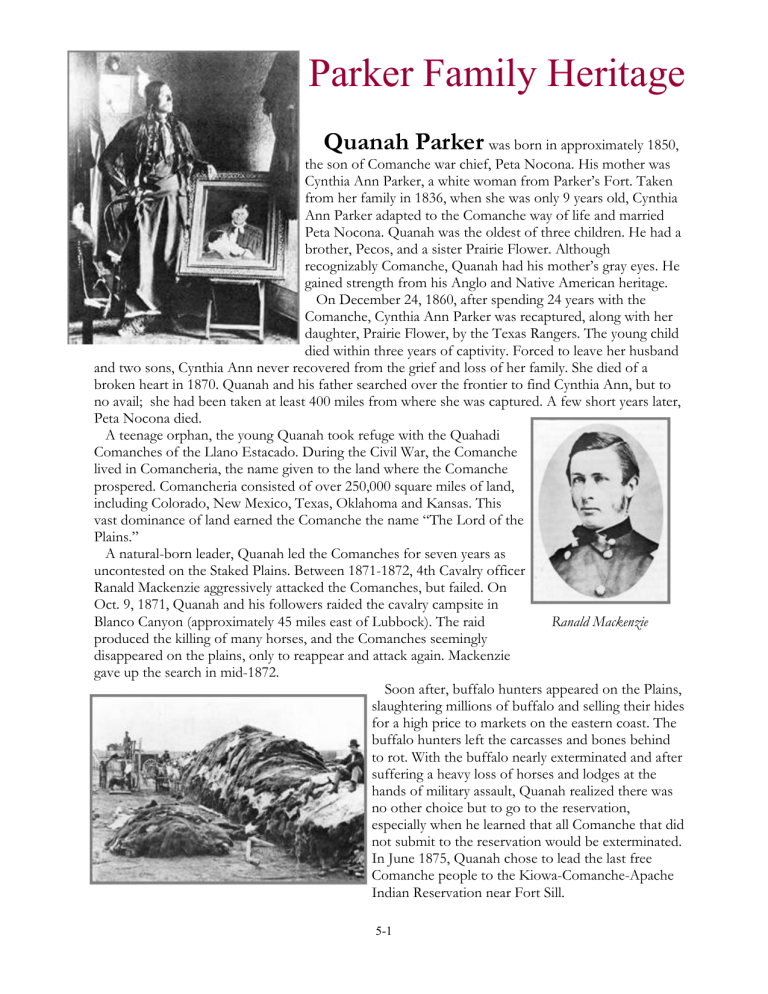
Parker Family Heritage
Quanah Parker
was born in approximately 1850, the son of Comanche war chief, Peta Nocona. His mother was
Cynthia Ann Parker, a white woman from Parker’s Fort. Taken from her family in 1836, when she was only 9 years old, Cynthia
Ann Parker adapted to the Comanche way of life and married
Peta Nocona. Quanah was the oldest of three children. He had a brother, Pecos, and a sister Prairie Flower. Although recognizably Comanche, Quanah had his mother’s gray eyes. He gained strength from his Anglo and Native American heritage.
On December 24, 1860, after spending 24 years with the
Comanche, Cynthia Ann Parker was recaptured, along with her daughter, Prairie Flower, by the Texas Rangers. The young child died within three years of captivity. Forced to leave her husband and two sons, Cynthia Ann never recovered from the grief and loss of her family. She died of a broken heart in 1870. Quanah and his father searched over the frontier to find Cynthia Ann, but to no avail; she had been taken at least 400 miles from where she was captured. A few short years later,
Peta Nocona died.
A teenage orphan, the young Quanah took refuge with the Quahadi
Comanches of the Llano Estacado. During the Civil War, the Comanche lived in Comancheria, the name given to the land where the Comanche prospered. Comancheria consisted of over 250,000 square miles of land, including Colorado, New Mexico, Texas, Oklahoma and Kansas. This vast dominance of land earned the Comanche the name “The Lord of the
Plains.”
A natural-born leader, Quanah led the Comanches for seven years as uncontested on the Staked Plains. Between 1871-1872, 4th Cavalry officer
Ranald Mackenzie aggressively attacked the Comanches, but failed. On
Oct. 9, 1871, Quanah and his followers raided the cavalry campsite in
Blanco Canyon (approximately 45 miles east of Lubbock). The raid Ranald Mackenzie produced the killing of many horses, and the Comanches seemingly disappeared on the plains, only to reappear and attack again. Mackenzie gave up the search in mid-1872.
Soon after, buffalo hunters appeared on the Plains, slaughtering millions of buffalo and selling their hides for a high price to markets on the eastern coast. The buffalo hunters left the carcasses and bones behind to rot. With the buffalo nearly exterminated and after suffering a heavy loss of horses and lodges at the hands of military assault, Quanah realized there was no other choice but to go to the reservation, especially when he learned that all Comanche that did not submit to the reservation would be exterminated.
In June 1875, Quanah chose to lead the last free
Comanche people to the Kiowa-Comanche-Apache
Indian Reservation near Fort Sill.
5-1
Comanche:
Lords of the Plains
Native Americans played an important role in Texas frontier history. The original inhabitants of West
Texas, the Comanche hunted the buffalo on the
South Plains, where miles and miles of fertile grass covered the landscape.
The Comanche were a nomadic people, moving from place to place in search of choice buffalo that provided for their every need—food, clothing and shelter. They were traders and controlled much of the commerce on the South Plains. They traded
Last Comanche Chief Quanah Parker buffalo products, horses and captives for manufactured items and other food.
However, it was also the horse that provided a successful way of life for the Comanche. It gave them the ability to follow the buffalo herds and the advantage of being able to hunt and conduct warfare on horseback. Wealth to the Comanche was measured by the number of horses he possessed, and horses were a valuable trade.
In 1836, the Comanche people were in complete control of the Texas plains and did not welcome the white men intruding upon their land. Frontier Texans coveted the Indians’ land, and raids increased as the Civil War left the frontier unprotected. Finally, the federal government stepped in and ordered the Comanche to move to reservation land. The Comanche, whose name means “anyone who wants to fight me all the time,” did not go quietly.
Soon, the Comanche saw their way of life rapidly vanishing and turned to a Quahadi medicine man for leadership. Isa-tai (later known as White Eagle) promised victory over the whites and attacked a buffalo hunter’s camp at Adobe Walls. The attack was unsuccessful.
Once numbering in the thousands, a Comanche population census of 1875 revealed the Comanche in Texas had been reduced to 1,597. They were forced to completely restructure their society, and the last great Comanche War
Chief Quanah Parker was instrumental in helping his people make that transition. Suffering a terrible loss, the Comanche people, once hunters and warriors, were becoming farmers and stockmen. Their cultural values and beliefs were constantly under attack.
Quanah Parker provided leadership to his people and promoted self-sufficiency and self-reliance. He fought fervently for peace and for his people as he did as a war chief. Quanah did not abandon his past or force his people to desert their traditions altogether. He considered himself a man who tried to do right to both the people of his tribe and to his “pale-faced friends.”
5-2
Quanah Parker
Man of Two Worlds
Quanah Parker’s life is the story of one of
America’s greatest leaders. Common to Native
American customs, where the identity of a man is conveyed in a single word, Quanah represented strength and dignity of the eagle. Quanah was a warrior who possessed the vision to take his people from the life of freedom on the Southern Plains and helped them adjust to reservation life.
Quanah Parker provided his people with determined leadership. He led by example and promoted self-sufficiency and self-reliance. He fought fervently for peace for his people.
As time passed on the reservation, Quanah served not only as chief of the Comanche but also as a sheriff and a tribal court judge. He lobbied against Congress and pleaded the cause of the Comanche Nation. Among his friends were cattlemen
Charles Goodnight, Burk Burnett and President Theodore
Roosevelt.
Quanah Parker and Burk Burnett
Possibly the wealthiest Indian in
America during his lifetime, Quanah
Parker was also a successful cattle rancher, businessman, accomplished horseman and able leader.
Quanah is pictured here with three of his seven wives and one of his 22 children on the porch of the Star
House in Fort Sill, Oklahoma.
5-3
Quanah Parker
Man of Two Worlds
Objectives
TLW identify Quanah Parker as the last of the Comanche War Chiefs and recognize his contributions as a peacemaker between the Comanche Nation and Texas cattlemen. TLW write a descriptive poem about Quanah Parker’s leadership.
TEKS
Geography 4.9, Social Studies 4.23, History 4.4
Building Background
• Read and discuss Comanche: Lord of the Plains (p. 2). Describe Comanche life on the South
Plains with and without the presence of the buffalo. Using the acitivity sheet, discuss the
cause and effect of different events in Comanche history.
Procedure
• Study the historical photographs of Quanah Parker (p. 1-3). As a group, list ways Quanah
maintained his Native American heritage. List how he adapted to the white man’s ways to
promote peaceful living among the Comanche people. Make a word map that tells
the story of Quanah Parker and his leadership in both the Native American and Anglo worlds.
• Read about Quanah Parker’s family heritage and make a timeline of his life. Add adjectives
and phrases to the class mind map.
• With a partner, make a list of words or phrases to describe Quanah Parker as a great leader
among the Comanche people and the white man.
• Model the beautiful language that can be used to describe a person by writing a cinquain. As a
group, write a cinquain about a chosen subject.
• The students will write a cinquain about Quanah Parker’s life. Illustrate.
• Using the Internet, textbooks or other resources, research the customs, traditions and lifestyle
of today’s Comanche people. In what ways do Comanche culture and language affect our
world?
Extend
Write About It!
Pretend you are a writer for the local newspaper. Write an obituary for Quanah Parker and tell of his impact as a leader among the Comanche people and ranching industry.
Sample cinquain:
River
Clear, Wonderful
Slapping, whirling, flowing
The river is cold.
Water
5-4
Comanche: Lords of the Plains
Cause Effect
• Comanche hunted buffalo on the plains.
• The horse changed the way the Comanche
lived.
• The white men coveted the Comanche’s land.
• The government ordered the Comanche to
move to reservation land.
• Quanah Parker fought for his people.
5-5
Quanah Parker
Born - 1850
Died Feb. 23, 1911
On his tombstone it is written:
Resting Here Until Day Breaks
And Shadows Fall and Darkness Disappears is
Quanah Parker
Last Chief of the Comanches
Born - 1850
Died Feb. 23, 1911
Do not stand at my grave and weep
I am not there, I do not sleep.
I am a thousand winds that blow
I am the diamond glint in snow
I am the sunlight on ripened rain.
When you wake in the morning hush.
I am the swift uplifting rush of quiet birds in circling flight.
I am the soft starlight at night.
Do not stand at my grave and weep.
I am not there, I do not sleep.
Ai!
5-6
5-7
